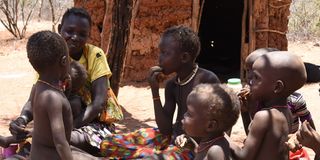Feed our children and secure their future

A woman with her children at Chesotim in Tiaty Sub-County. The family has gone without food for two days.
What you need to know:
- Kenya’s food insecurity is a matter of national concern. It is not just a health issue but it is an inter-sectoral issue.
- As our ministries of Health and Education battle the perennial issue of school dropout for our adolescent mothers with the collaboration with the local government, we need to see the involvement of the Agriculture, Trade and industry sectors coming together to address one of the root causes of this dismal situation — food security.
Last week I had the privilege of spending time with the First Spouses from the various counties across the country and listening to the agenda they have in place for health advocacy in their respective regions. Prior to this engagement, I must admit that I had limited perception of their scope as they are not given as much visibility as their national counterparts.
The First Spouses are brought together under the County First Ladies’ Association, an entity that has been in existence for the past 10 years. The association, now pressed to review its name in view of the fact that we have a lot more First Spouses who are not ladies, has focused entirely on championing for the social welfare of their constituents. They represent the apolitical interests of the people despite the fact that the Constitution fails to recognise their office.
In an advocacy engagement with the association, I had the opportunity to truly see their counties through their own eyes. Across board, the common issue of concern was childhood malnutrition. The Kenya Demographic Health Survey (KDHS) 2022 did not exaggerate. Malnutrition is rife in our counties, and no, it is not only limited to the ASAL (arid and semi-arid land) counties.
Counties such as Turkana, Wajir and Marsabit have lived with continuous drought for so long that finding a healthy child is the exception rather than the norm. It was heartbreaking to listen to the County First Gentleman from Meru narrating how kindergarten children are passing out from hunger at school. Whereas the perception out here is that Meru is a rich fertile region, with lots of rain and food in plenty, half of the county is semi-arid, having faced serious drought in the past two years. His sole commitment right now is to advocate for a robust school-feeding programme for all children attending early childhood development institutions in the county, to ensure these little ones get at least one healthy and nutritious meal a day.
In Laikipia, human-wildlife conflict has greatly contributed to food insecurity, with women and children being the hardest hit. In Migori, where food is adequate, lack of knowledge in nutrition is the Achilles’ heel. Mothers will be in the market, selling their millet and fish, in order to buy bread and mandazi for their toddlers!
Nutrition is the foundation of health and development. The circle of life is hinged on the nutrition status of an individual. An underweight, malnourished, anaemic pregnant mother is likely to give birth to a low-birth-weight baby. With insufficient breastfeeding support, the baby is already disadvantaged from the get-go.
With inadequate nutrition courtesy of food insecurity, poor weaning practices and inadequate knowledge on child nutrition, the baby is likely to grow into a malnourished child, whose brain development is grossly compromised at this delicate age and remains a yoke on his shoulder for life.
How then, pray tell, do we expect this child to shake off this disadvantage when they cannot compete fairly against their peers, in education, innovation and opportunity in life? Even worse when they are growing up in a country where progression to the next level of education is dependent on how well you perform in your current level.
The KDHS-2022 highlighted that the single most important factor influencing the rate of adolescent pregnancy is the level of education, dropping from 30 per cent for those with no education to 4 per cent for those with education beyond secondary level. Our young girls’ chances of advanced education are severely compromised when malnutrition remains a threat to their intellectual capacity. Malnutrition remains a secondary cause of increased risk for adolescent pregnancy.
The reality staring at us in the face is that the malnourished adolescent will end up restarting this vicious cycle! It is most definitely setting her and her future generation up in a vicious cycle of poverty, malnutrition, early marriage and the resultant negative effects that follow, including sexual and gender-based violence.
This must stop! We must break the vicious cycle! It starts with nutrition. We must feed our infants, babies, children, adolescents and pregnant women. We must ensure our adolescents thrive and are not held back by unplanned pregnancies that give rise to desperate situations be-getting poverty.
Kenya’s food insecurity is a matter of national concern. It is not just a health issue but it is an inter-sectoral issue. As our ministries of Health and Education battle the perennial issue of school dropout for our adolescent mothers with the collaboration with the local government, we need to see the involvement of the Agriculture, Trade and industry sectors coming together to address one of the root causes of this dismal situation — food security. The health education can be handled easily once we strengthen primary healthcare.
Nutrition is a basic right for all. Let us all add our voices to the conversation, let us ensure our children are fed!
Dr Bosire is an obstetrician/gynaecologist





